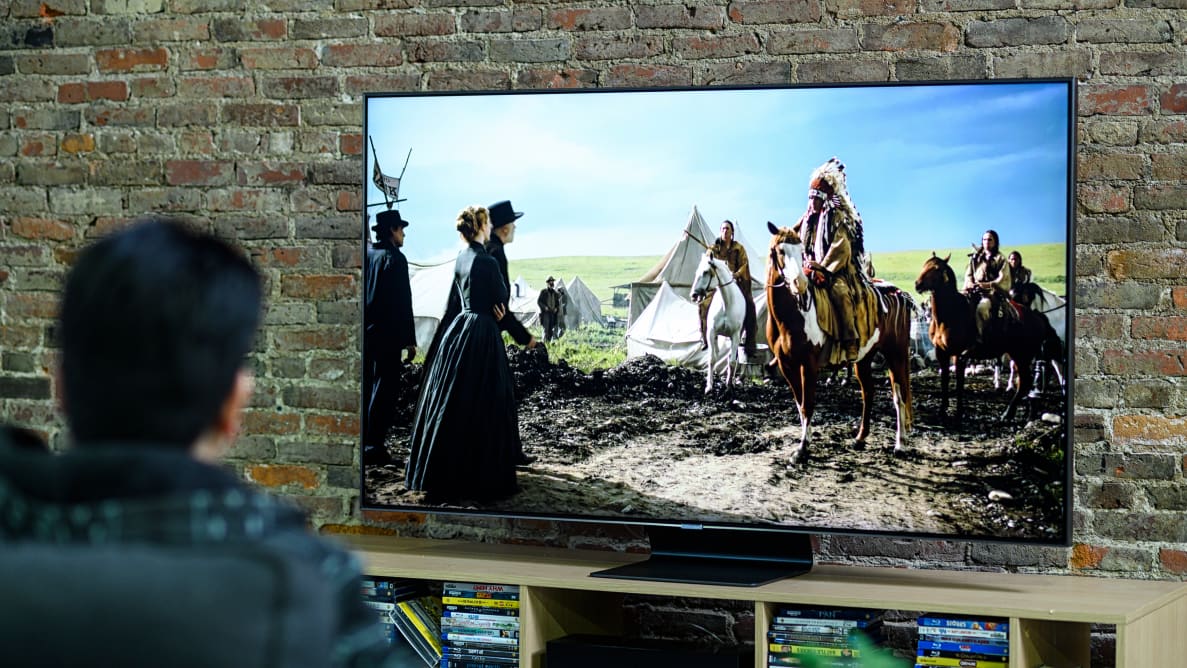Pros
-
Bright, colorful QLED-backed performance
-
Sleek design
Cons
-
Priced at a premium
Its price shouldn't be that surprising, either, however. Samsung isn't exactly known for its cost-cutting measures, and this is a top-tier TV with premium hardware. It features a quantum dot display (hence the "QLED" moniker), a posh design, and impressive engineering.
There are more affordable alternatives out there, though—TVs that come close to the Q90R's performance but nevertheless cost less. Like any tradeoff, it comes down to what you're willing to pay for.
About the Samsung Q90R
About the Samsung Q90R
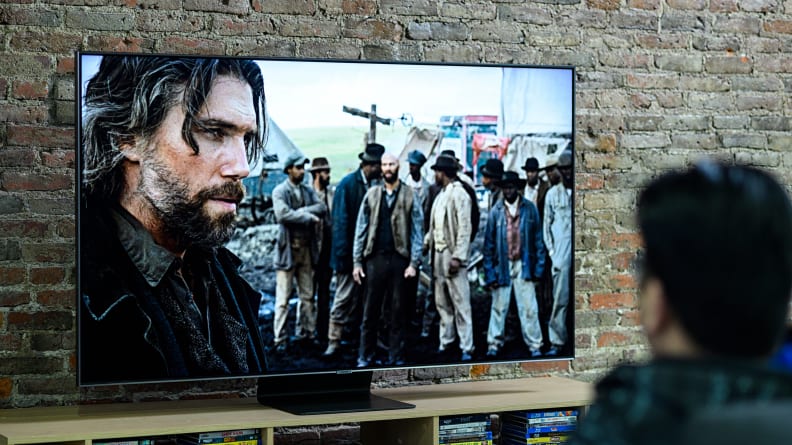
• 65-inch Samsung Q90R (QN65Q90RAFXZA): MSRP $2,599.99 • 75-inch Samsung Q90R (QN75Q90RAFXZA): MSRP $3,499.99 • 82-inch Samsung Q90R (QN82Q90RAFXZA): MSRP $4,499.99
Different sizes of TVs in a series tend to perform similarly to one another, unless elements of the TV's hardware change drastically between sizes. This often is the case with backlit TVs whose total number of LED zones is dependent on panel size, but to my understanding, each of the three sizes in the Q90R series feature the same amount of LED zones: 480. I don't expect there to be too much of a difference between the 65-, 75-, and 82-inch versions of the Q90R.
Here are some key features shared by all of the size variants in the Q90R series:
• 4K (3,840 x 2,160) resolution • Quantum dot color • Full-array backlight with local dimming • Supports High Dynamic Range (HDR10, HDR10+, and HLG) • Native 120 Hz refresh rate • Built-in smart platform (Tizen OS) • DCI-P3/10-bit color space
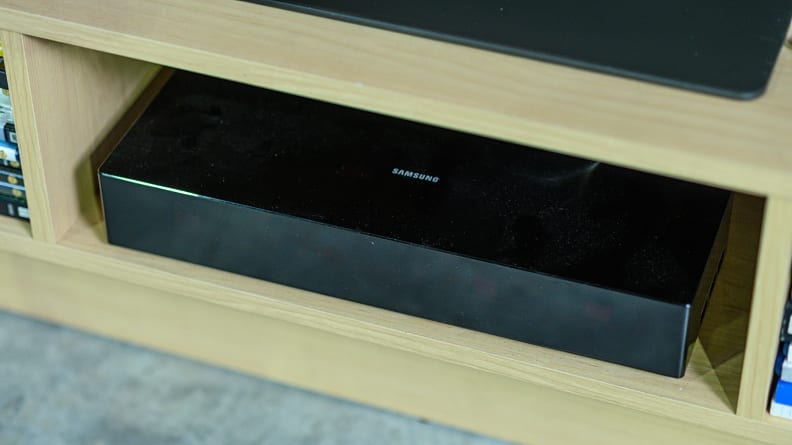
Like most of Samsung's higher-end TVs these days, the Q90R's connectivity ports reside on an external device called the One Connect box, which is included with every Q90R. The box connects to the back of the TV by way of a thin cable.
Here's what you'll find in on the back of the One Connect box:
• 4x HDMI 2.0 (1x ARC) • 3x USB 2.0 • LAN ethernet port, RF input, optical audio output
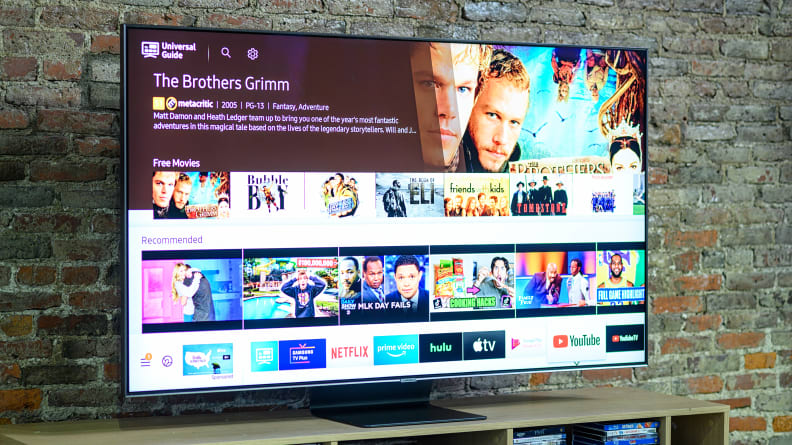
The Q90R is equipped with Samsung's Tizen-based smart platform, and for the most part, the software is quick to boot and easy to navigate. The app selection is ample and customizable.
Performance Data
Performance Data
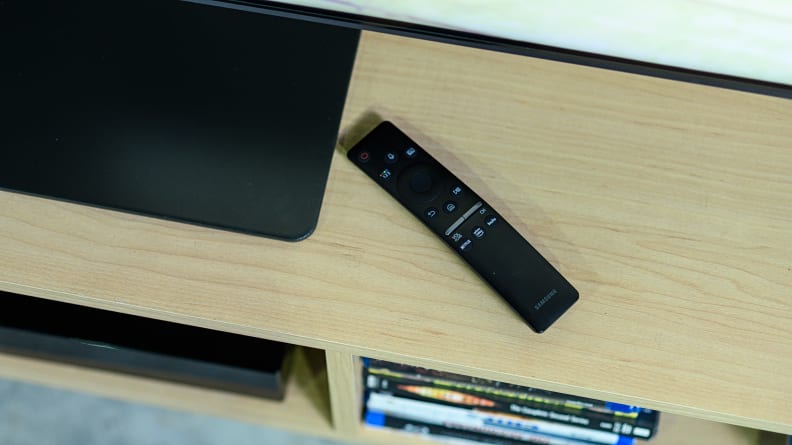
Before testing each TV, we make sure the panel is on and receiving a continuous signal for at least 24 hours, allowing the pixels plenty of time to warm up.
For SDR tests, we used the Samsung Q90R’s “Movie” picture setting. For HDR tests, we also used the Samgung’s “Movie” picture setting.
We use a standard ANSI checkerboard pattern for most of our basic contrast tests (including the ones reported below), but we also use white and black windows ranging from 2% to 90% to test how well the contrast holds up while displaying varying degrees of brightness.
I'll expand on our test results throughout the review, but for now, here are some key takeaways:
• HDR contrast (brightness/black level): 612.5 nits/ 0.115 nits (ANSI checkerboard) • SDR contrast (brightness/black level): 170.4 nits/ 0.045 nits (ANSI checkerboard)
• HDR peak brightness: 1,411 nits (40% white window)
• HDR color gamut coverage: 94% (DCI-P3/10-bit) • SDR color gamut coverage: 97% (Rec.709)
• Viewing angle: ±15°
What We Like
What We Like
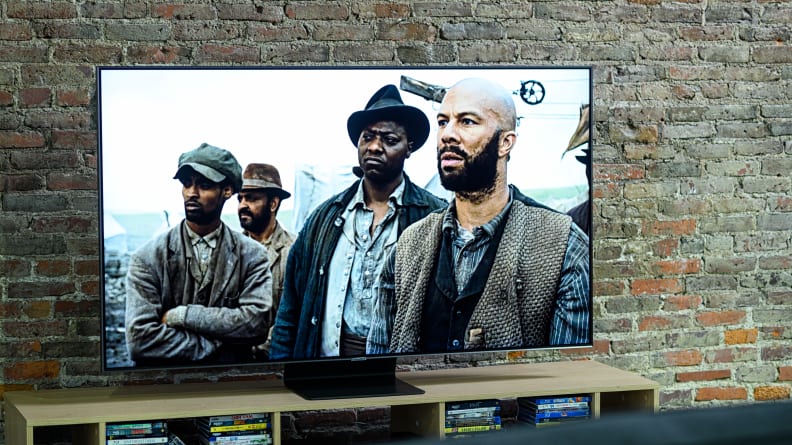
The Q90R is a spectacularly bright television, making it a game-changing TV for folks with bright living rooms and an impressive home theater centerpiece for folks who watch their flicks in the dark. Even SDR content (the bulk of what most people watch on a day-to-day basis) is impressively bright.
Where the Q90R really shines is during HDR content. I routinely clocked the Q90R's quantum dot display at well over 1,000 nits during HDR playback, with its peak brightness levels eclipsing 1,400 during especially vivid content.
The Q90R's color production is equally as impressive; it covers about 94% of the wide P3 color gamut, and although that figure is slightly lower than I expected it to be, the colors look as dazzling as they do on any given OLED. It really does come down to the Q90R's brightness.
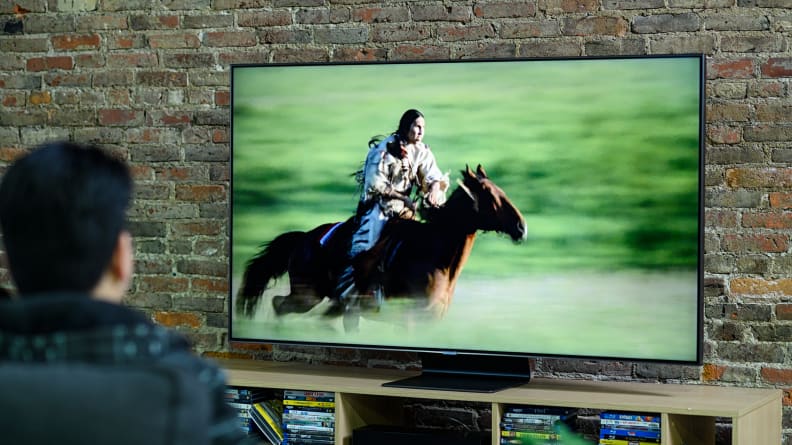
Gamers and sports aficionados will be happy to learn that the Q90R's motion handling is as impressive as I've seen on any other high-end TV from 2019. It features a native refresh rate of 120 Hz with additional motion interpolation options at the user's fingertips. Depending on the type of content you might decide to make some adjustments, but I found virtually no judder and or trailing even with these features disabled.
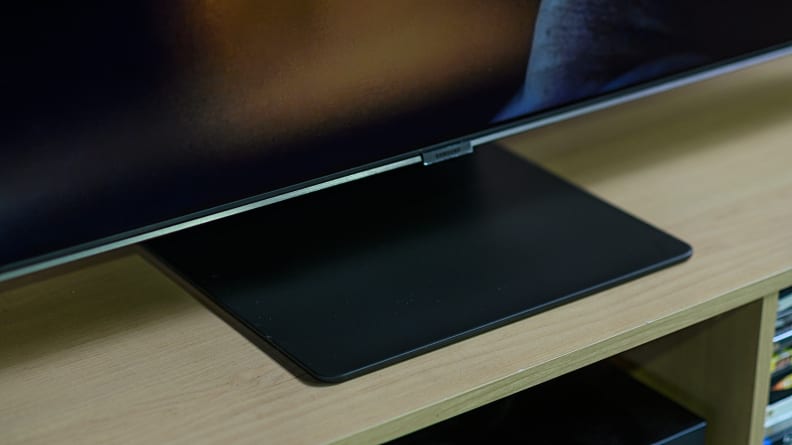
From a design standpoint, the Q90R couldn't be sleeker. Its smooth, metallic stand sits beneath the center of the panel and curves behind it, allowing room for a soundbar. The bezels are narrow and even in size, putting the Q90R's picture front and center. The TV's design is pleasing overall, and convenient if you've got a soundbar front and center.
What We Don't Like
What We Don't Like
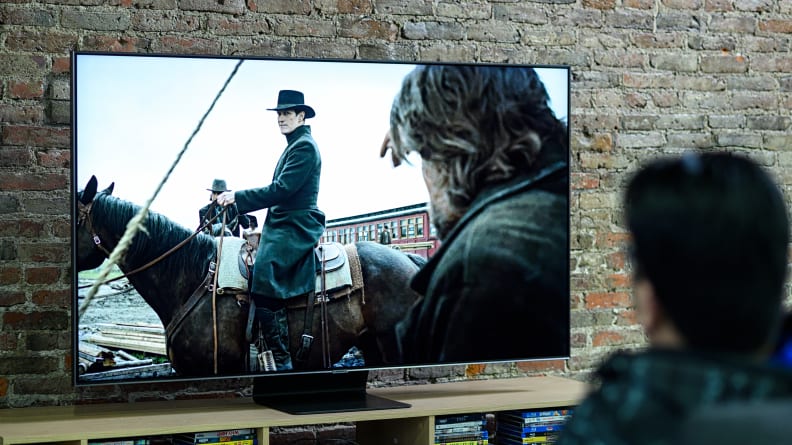
Like several Samsung offerings this year, the Q90R features something the company refers to as "Ultra Viewing Angle." It's essentially an extra optical layer designed to keep the picture from deteriorating at off-center viewing angles. Unfortunately, while I do think that the tech helps slightly, it's not effective enough to stop the picture from getting washed out when viewed from an off-angle. Even at around 20°-30°, viewers will likely notice a drop in contrast.
The Q90R features a VA-style panel, which aren't exactly known for wide viewing angles, but it's still disappointing to see such an otherwise great TV flop in the viewing angle department—especially given the addition of its much ballyhooed optical layer.

We should also talk about price. Despite the Q90R's impressive hardware and performance, the 65-inch model is currently on sale for about $2,600. This isn't quite as collar-tug-worthy as, say, a new LG OLED of the same size, but it's still a hefty fee for a top-tier QLED TV that only slightly outpaces other TVs in its weight class. For $700-$800 less, you could nab yourself a similar QLED TV whose shortcomings wouldn't be glaring enough to feel like you've missed out on $700-$800 worth of advantages.
The Q90R also lacks Dolby Vision support, though it does support HDR10+ and HLG. I don't expect that to be a deal-breaker for most people, but if you'd rather spring for a TV that meets higher HDR standards, you might thank yourself sometime down the road when HDR content is more prolific.
Should You Buy It?
Should You Buy It?
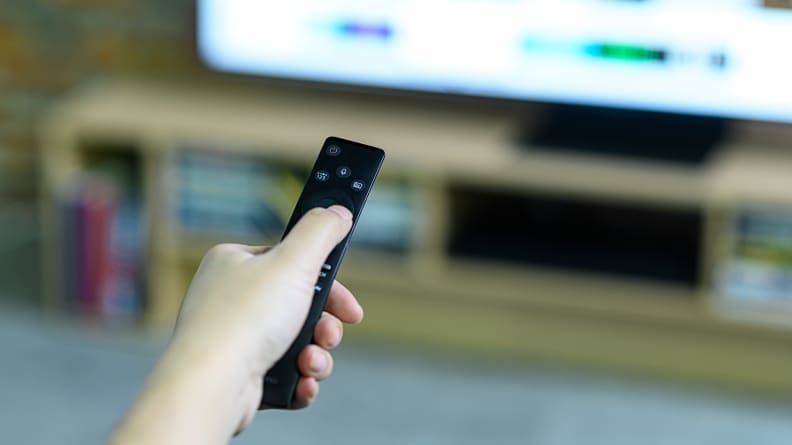
Yes—The Samsung Q90R is one of the best-performing non-OLED TVs you can buy.
Beyond the specs and test results, the best thing the Q90R has going for it is its versatility; this is a TV that will perform exceptionally, regardless of your media proclivities, in just about every setting. Its contrast can hold up in brightly lit rooms, its motion handling is stellar, and while we still have our nitpicks with the smart platform, the software is friendly and flexible enough to get your back if you don't already own a dedicated streaming device.
Here's the deal, though: When it comes to cost, this TV isn't much of a compromise. It outpaces most TVs in its price range, but there are more affordable options that folks should explore before paying a premium for the sleek sophistication of a flagship Samsung TV. The Vizio P Series Quantum X is another bright, colorful quantum dot TV that's still available, and while its smart platform isn't as desirable as the Q90R's, its price is much lower. The TCL 8-Series is another bright QLED TV with great performance chops. It's not quite as versatile as the Q90R, but I imagine the difference in price will make it a better option for a lot of people.
All told, the Samsung Q90R is a phenomenal QLED TV despite its hefty price tag, and a TV that's well-suited for everyone: cinephiles, sports fans, and gamers.
Meet the tester
Michael Desjardin graduated from Emerson College after having studied media production and screenwriting. He specializes in tech for Reviewed, but also loves film criticism, weird ambient music, cooking, and food in general.
Checking our work.
Our team is here to help you buy the best stuff and love what you own. Our writers, editors, and experts obsess over the products we cover to make sure you're confident and satisfied. Have a different opinion about something we recommend? Email us and we'll compare notes.
Shoot us an email
